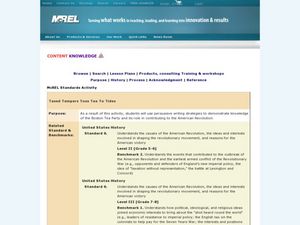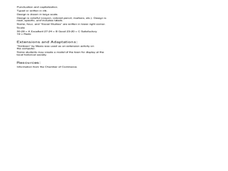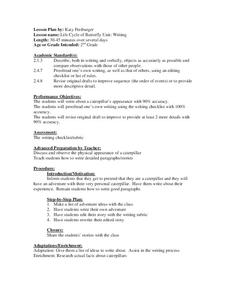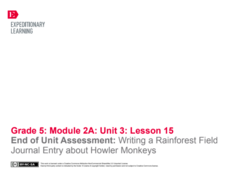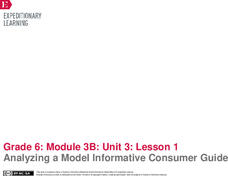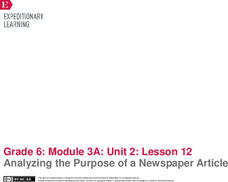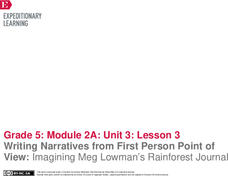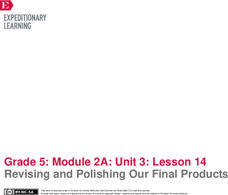Curated OER
BECOME A LOGOPHILE
It's time to write! First, lead your emerging writers in a power writing activity. It takes six minutes and focuses on creative brainstorming. The class is given two words (duck and apple are suggested, but alter the words for different...
Curated OER
Goldilocks: The Sequel
Students explore their creative-thinking and writing skills while writing a sequel to the classic story, "Goldilocks and the Three Bears". Students work in small groups to complete this activity and share their completed story with the...
Curated OER
Taxed Tempers Toss Tea To Tides
Engage learners in persuasive writing, research, and creative thinking. They research the series of events that led to the Boston Tea Party and create brochures that include propaganda intended to rally Patriot support or dissuade...
Curated OER
Shakespeare 2000
Young thespians can try their hand at writing a script and acting out a scene, while gaining a deeper understanding of the universal topics presented in Shakespeare's wide array of plays. Begin the lesson by conducting a compare and...
Curated OER
Collaborative Editing
With the use of an online editing site, budding authors revise their writing. This is a creative way to have your class practice essay revision. Instead of being a tedious process, editing and revising can be fun.
Curated OER
Memory & Song, Malagan Figures from New Ireland, Papua New Guinea
Students investigate the uses of images, shapes and colors in classic art sculptures. In this art analysis lesson, students observe Malagan Figures, a type of sculpture from New Guinea, and describe the different ideas and images...
Curated OER
Poetry Coffeehouse
This resource contains a vague plan for a poetry unit conducted at an elementary school during the month of February. Although this plan does not included detailed instructional strategies, this does outline a basic unit, some creative...
Curated OER
How to Score in the Word Series
Students examine an object in the classroom and write a description of it employing exciting language. They brainstorm and outline ideas for an original article about an event they participated in or attended.
Curated OER
Change for the future: Redesigning Maquoketa
Sixth graders research a problem to be solved in their town, develop a rationale as to why they should act on this problem, and present their ideas to the class and their community. In this problem solving lesson plan, 6th graders...
Curated OER
Pizzazz!...Basket Stories
Pupils discuss the use of connectors and sequence words. They discuss common story endings and beginnings. Students brainstorm ideas for a creative story and compose a story for the rest of the class.
Curated OER
Lesson Plan for Waiting to Waltz: A Childhood by Cynthia Rylant
Sixth graders examine the elements of writing poetry. In this creative writing lesson plan, 6th graders discuss a book of poetry in the setting of Appalachia. Students incorporate childhood experiences into the development of visual and...
Curated OER
Life Cycle of Butterfly
Second graders investigate life cycles of insects by writing a story. In this butterfly life lesson plan, 2nd graders create a checklist of the many steps a caterpillar takes before growing wings and flying. Students utilize...
Curated OER
Creative Writing with Images
Students take digital pictures and write creative stories around them in an electronic storybook. Using WebBlender, they publish their final project as a Website. They also present their stories to students, parents, and community members.
EngageNY
End of Unit Assessment: Writing a Rainforest Field Journal Entry about Howler Monkeys
Give me more details. Scholars complete an end of unit assessment by creating an information text box to go with their field journal entries about howler monkeys. Learners use the class time to work independently.
EngageNY
Analyzing Text Structure: “Water Is Life” Paragraphs
Water, water everywhere. Readers revisit paragraphs six through nine in the article "Water is Life" to answer text-dependent questions. They then pair up to reread the article focusing on its structure and record their thoughts on...
EngageNY
Analyzing a Model Informative Consumer Guide
What do consumers need to know about overfishing before buying fish? Scholars consider the question as they prepare for their performance task, which is to create a consumer guide for people about purchasing fish responsibly. After...
EngageNY
Analyzing the Purpose of a Newspaper Article
Shh! No talking during the discussion! Using the resource, scholars engage in a silent discussion called a Chalk Talk activity to analyze the purpose of a newspaper article. Additionally, they read a model newspaper article and try to...
Food a Fact of Life
Creative Crumbles
Class cooks practice the rubbing technique and the preparation of a range of bases to produce an apple and sultana or herby veggie crumble.
EngageNY
Taking Notes Using a Graphic Organizer: Inferring About the Importance of Religion in Colonial America
Improve class understanding of colonial times by reading an informational text and filling out the accompanying graphic organizer. Class members work with a partner to read, take notes, make inferences, and synthesize information.The...
EngageNY
Writing Narratives from First Person Point of View: Imagining Meg Lowman’s Rainforest Journal
I spy with my little eye! Learners observe page 23 in The Most Beautiful Roof in the World and practice what they would add to a field journal. They discuss how details from the text help add to their thoughts. To finish,...
EngageNY
Revising and Polishing Our Final Products
One, two, three go! Scholars work independently to finalize the three components of their final task. They complete a science journal entry, scientific text box, and scientific drawing. While working, learners sign up for an...
Curated OER
Finding Meaning in the Badge
Children who are three to five years old study two rank badges from the Qing dynasty to develop an understanding of social rank, language skills, and symbolism. The instructional activity is discussion-based and requires learners to...
EngageNY
Mid-Unit 2 Assessment: Analyzing Narrative Structure and Author’s Craft: Part 1
Using the resource, scholars complete a mid-unit assessment to gauge their learning at the halfway point of the unit. Pupils read the myth "The Harvest That Never Came" and plot its narrative structure.
Curated OER
Introducing Communication Talent with "Casey at the Bat"
Analyze the poem "Casey at the Bat." Your team of analysts will read the poem and complete a variety of activities, including describing how Casey looks and acts, describing how he feels before and after he strikes out, and sharing...


